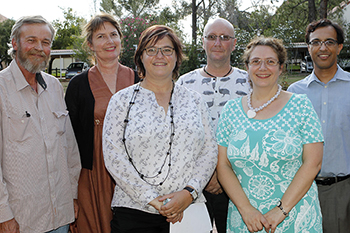
Researchers at the university were acknowledged for their new research ratings. From the left are: Prof Johann de Wet, Department of Communication Sciences; Prof Naomi Morgan, Department of Afrikaans and Dutch, German and French; Prof Corli Witthuhn, Vice-Rector: Research; Prof André Pelser, Department of Sociology; Dr Trudi O’Neill, Department of Microbial, Biochemical and Food Biotechnology; and Prof Riaz Seedat, Department Otorhinolaryngology. |
During a recent gala occasion, the University of the Free State (UFS) acknowledged 15 of its researchers who received new ratings from the National Research Foundation (NRF).
According to Prof Corli Witthuhn, Vice-Rector: Research at the UFS, 37 applications have already been received for the next round of ratings by the NRF. In recent years, the university has experienced an increase in the rating of its researchers as the result of raised academic standards. These are in line with the Academic Project of the UFS. The UFS has 125 rated researchers in total.
The 15 recipients of new ratings from the NRF in 2015,are:
- Dr Tanya Beelders, Computer Science: Y2
- Dr Andrew Cohen, History: Y1
- Prof Pieter de Villiers, Theology: C2
- Prof Johann de Wet, Communication: C3
- Dr Angelinus Franke, Agriculture: C2
- Prof Jonathan Jansen, Education: B1
- Prof Riaan Luyt, Chemistry: B3
- Prof Naomi Morgan, Linguistics: C2
- Dr Trudi O’Neill, Microbiology: C1
- Prof André Pelser, Sociology: C3
- Dr Johann Rossouw, Philosophy: C2
- Prof Riaz Seedat, Health: C3
- Dr Jakub Urbaniak, Theology: Y2
- Dr Martin van Zyl, Mathematics: C3
- Prof Sue Walker, Soil, Crop and Climate Sciences: C1
The UFS also celebrated its five SARChI research chairs during this event. The main goal of the research chairs is to promote research excellence.
The five research chairs at the UFS are all established at Tier 1. Research chairs in the Tier 1 category are based on the researcher's research track record, as well as on the training record of his/her postgraduate and postdoctoral students. Tier 1 research chairs are awarded to established researchers who are leaders in their field, and whose work is recognised internationally.
The following research chairs have been awarded to the UFS since 2013:
- Solid State Luminescent and Advanced Materials, Prof Hendrik Swart in the Department of Physics (2013-2017)
- Disease Resistance and Quality in Field Crops, Prof Maryke Labuschagne (2016-2020)
- Higher Education and Human Development, Prof Melanie Walker (2013-2017)
- Vector-Borne and Zoonotic Pathogens, Prof Felicity Burt (2016-2020)
- Humanities without Borders: Trauma, History and Memory (2016-2020)